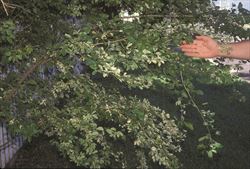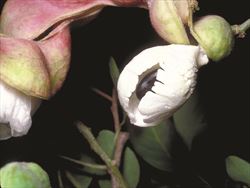Click on images to enlarge

habit (photo: Biosecurity Queensland)

flowering branch (photo: Biosecurity Queensland)

thorns (photo: Biosecurity Queensland)

seed (photo: Biosecurity Queensland)
Scientific Name
Pithecellobium dulce (Roxb.) Benth.
Synonyms
Inga dulcis (Roxb.) Willd.
Mimosa dulcis Roxb.
Family
Fabaceae: sub-family Mimosoideae (New South Wales)
Leguminosae (South Australia)
Mimosaceae (Queensland, the ACT, Victoria, Tasmania, Western Australia and the Northern Territory)
Common Names
Madras thorn, Manila tamarind, monkey pod
Origin
North, Central and South America, from California down through Mexico to Venezuala
Naturalised Distribution
Cultivated in north Queensland from Townsville to Cairns in North Queensland. Also in the Northern Territory around Darwin.
Habitat
Drought and salt tolerant, and able to grow in poor soils.
Habit
Shrub or small multistemmed tree to 20m tall
Distinguishing Features
- a pair of straight stout short thorns at the base of the leaf
- bipinnate leaves with a single pair pinnae, each with a single pair of leaflets
- leaflets often varietated
- white flowers in globular heads c. 1 cm wide
- coiled pinkish pods
- shiny black seeds c. 1 cm long, embedded in white pulp
Stems and Leaves
Young stems and branches have smooth or slightly rough bark with small white patches (lenticels). Spines (when present) are straight, short and stout, arranged in pairs at the base of leaves. Leaves are abruptly bipinnate with just 1 pair of pinnae and one pair of leaves per pinna (= 4 leaflets). Leaflets are ovate to obovate, 2-5 cm long and 1-3 cm wide, and are often variegated.
Flowers and Fruit
Flowers are white or cream and frangrant, arranged in globular heads c. 1 cm wide on short stalks. The heads are arranged in terminal or axillary panicles up to 30cm long. The petals are softy hairy. Pods are coiled and often twisted, green or slightly pinkish, and 1-2cm wide with c. 10 seeds. The seeds are black, shiny and c. 1cm long surrounded by an edible white pulp.
Reproduction and Dispersal
Reproduces by seed, dispersed by birds. Also reproduces from cuttings and root suckering.
Environmental Impact
Madras thorn (Pithecellobium dulce ) is not yet naturalised in Australia, but is a serious weed elsewhere. It can grow in poor soils, is brackish water and in dry areas, forming dense thickets. It readily grows from seed and damage to roots causes suckering. Potentially invasive of open forests across the tropics.
Other Impacts
Madras thorn (Pithecellobium dulce ) is potentially invasive of pastures in the tropics.
Legislation
This species is declared under legislation in the following states and territories:
- Queensland: Class 1 - introduction into the state is
prohibited, and landowners must take reasonable steps to keep land free of
this species (throughout the entire state). It is also illegal to sell a
declared plant or its seed in this state.
Similar Species
The leaves superficially resemble those of Bauhinia species but these species have a 2-lobed leaf (not bipinnate). It is related to the horticultural ice-cream bean (Inga edulis) but this species has pinnate leaves with a winged rachis, and the pods are not coiled.

